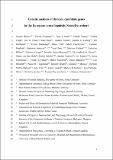Genetic analysis of dyslexia candidate genes in the European cross-linguistic NeuroDys cohort
Abstract
Dyslexia is one of the most common childhood disorders with a prevalence of around 5-10% in school-age children. Although an important genetic component is known to have a role in the aetiology of dyslexia, we are far from understanding the molecular mechanisms leading to the disorder. Several candidate genes have been implicated in dyslexia, including DYX1C1, DCDC2, KIAA0319, and the MRPL19/C2ORF3 locus, each with reports of both positive and no replications. We generated a European cross-linguistic sample of school-age children - the NeuroDys cohort - that includes more than 900 individuals with dyslexia, sampled with homogenous inclusion criteria across eight European countries, and a comparable number of controls. Here, we describe association analysis of the dyslexia candidate genes/locus in the NeuroDys cohort. We performed both case-control and quantitative association analyses of single markers and haplotypes previously reported to be dyslexia-associated. Although we observed association signals in samples from single countries, we did not find any marker or haplotype that was significantly associated with either case-control status or quantitative measurements of word-reading or spelling in the meta-analysis of all eight countries combined. Like in other neurocognitive disorders, our findings underline the need for larger sample sizes to validate possibly weak genetic effects.
Citation
Becker , J , Czamara , D , Scerri , T S , Ramus , F , Csépe , V , Talcott , J B , Stein , J , Morris , A , Ludwig , K U , Hoffmann , P , Honbolygó , F , Tóth , D , Fauchereau , F , Bogliotti , C , Iannuzzi , S , Chaix , Y , Valdois , S , Billard , C , George , F , Soares-Boucaud , I , Gérard , C-L , van der Mark , S , Schulz , E , Vaessen , A , Maurer , U , Lohvansuu , K , Lyytinen , H , Zucchelli , M , Brandeis , D , Blomert , L , Leppänen , P H , Bruder , J , Monaco , A P , Müller-Myhsok , B , Kere , J , Landerl , K , Nöthen , M M , Schulte-Körne , G , Paracchini , S , Peyrard-Janvid , M & Schumacher , J 2014 , ' Genetic analysis of dyslexia candidate genes in the European cross-linguistic NeuroDys cohort ' , European Journal of Human Genetics , vol. 22 , no. 5 , pp. 675-680 . https://doi.org/10.1038/ejhg.2013.199
Publication
European Journal of Human Genetics
Status
Peer reviewed
ISSN
1018-4813Type
Journal article
Description
The work conducted at the WTCHG was supported by Wellcome Trust grants [076566/Z/05/Z] and [075491/Z/04]; the work in Zurich partly by an SNSF grant [32-108130]. We also thank MAF (Mutation Analysis core Facility) at the Karolinska Institute, Novum, Huddinge. The French part of the project was funded by Agence Nationale de la Recherche (ANR-06-NEURO-019-01 GENEDYS) and Ville de Paris. S Paracchini is a Royal Society University Research Fellow. D Czamara was supported by the Deutsche Forschungsgemeinschaft (German Research Foundation) within the framework of the Munich Cluster for Systems Neurology (EXC 1010 SyNergy).Collections
Items in the St Andrews Research Repository are protected by copyright, with all rights reserved, unless otherwise indicated.

